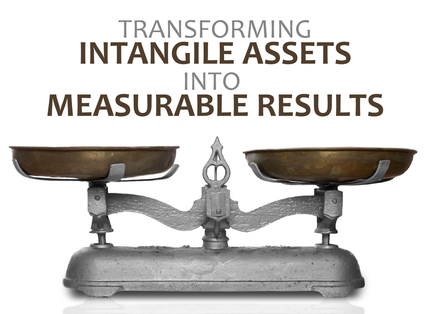 Have you ever noticed that the more you practice something the better you understand it? I experienced this with the Balanced Scorecard strategy management technique over the past 20 years. I remember reading The Balanced Scorecard (Kaplan and Norton, 1996) and applying what I learned. A year later, I read it again and picked up new understanding. As I continued to apply the methodology, I would refer back to sections of the book and always learn something new. One concept that always intrigued me was the idea that strategy transforms intangible assets into measurable financial results. What the heck did that mean? I probably skipped through that section the first couple of times that I read the book. And then it hit me. Intangible assets refer to organizational capital (your culture), human capital (your people) and information capital (your data). Our strategy leverages these assets to create value for our clients and revenue for our business. Information Capital Information capital is probably the easiest to explain because most industry disruption, today, is based on technology or, more specifically, data. Let’s explore a couple of examples. In the late 1990’s I worked for Reed Elsevier, one of the largest publishing companies in the world. We published, among many other titles, the Hotel and Travel Index, which was the “bible” of the travel agency industry. Microsoft approached us to see if they could use our database – the deepest and broadest source of hotel and destination information in the world. I then helped Microsoft create an online travel site called Expedia. Based on our data, Expedia became the world’s leading online travel company. Expedia transformed information capital, or data, into a new, fast, easy, inexpensive service for its customers and, ultimately, great value for its shareholders. You can look at Amazon, Uber and Airbnb the same way. Like Expedia, they all transformed information capital into customer value and revenue. The key for all of these disrupters was that they used their information in new, unique ways to create value for their customers. Organizational Capital Organizational capital refers to your culture. If you ever stayed at a Four Seasons resort, you’ll probably never forget the level of customer service. And if you stayed at several Four Seasons resorts, you’re probably amazed at the culture of customer service that permeates their organization. The culture of customer service is central to the Four Seasons strategy. Nordstrom has a similar culture of customer service. Zappos has a culture of happiness. Google has their rule about spending 20% of your time on anything you want, or searching your inner self. That’s embedded in their culture. Netflix has a famous culture of “freedom with responsibility”. For each of these companies, and many more that are similarly driven, culture doesn’t just happen. It is central to their strategy. These companies transform their culture, organizational capital, into a great customer experience that drives revenue and profits. Human Capital Human capital refers to your people, with their unique skills, knowledge and experience. As your strategy brings your business to new heights, do you have the human capital to take that journey? I’ve seen too many organizations set lofty strategic objectives only to discover, after it’s too late, that they didn’t have the skills to achieve those goals. Workforce strategy and talent development are getting more attention than ever. IT organizations, with the looming talent war, are becoming more and more sensitive to these. Zappos, Four Seasons, Netflix and Google have created their own “culture brand”. Expedia, Amazon, Uber and Airbnb have created their unique “information brand”. What are you doing to create your Talent Brand? Today’s competitive workforce demands personal development, internal mobility, and clarity of purpose. Companies seek higher levels of employee engagement and greater learning agility. When you put these together, you define your Talent Brand, which not only indicates how you transform human capital into tangible results but is also is crucial to recruiting and retention. Transform Intangible Assets into Measurable Results Efficient processes and strong technical skills are no longer sufficient to succeed, or survive, in this age of rapid disruption. Every organization has unique information, culture and talent – the intangible assets that are so often, sadly, omitted from strategy. If you are not leveraging these assets to differentiate or disrupt, then you are missing a huge opportunity and could be at risk of the next disrupter. Changing the Conversation O&A Unleashes the Power of IT by Developing the Human Side of Technology and Changing the Conversation About IT Strategy, Culture and Talent. Strategy, flawless execution, innovation and a service culture are fundamental requirements of every IT organization, and business, today. We prepare every member of the IT team to take their game to the next level, to move IT up the maturity curve to become the Strategic Partner and Innovative Anticipator (TM) that doesn’t just align with the business, but drives the business.
5 Comments
3/13/2018 07:44:21 am
Thanks- Larry, for your commendable perspective. I would like to tell that monetizing organizational, human, and information capital can be a herculean endeavor. I think it is one of the most significant complications in the field of human resource administration. If anyone considers my standpoint, then I can say that it is out of these three capital resources, human capital is highly important for an establishment because it is the possession containing knowledge and expertise held by an individual which can be implemented by the sphere for advancing its objectives. Thus, a few precautionary measures have to be taken during its monetization.
Reply
3/13/2018 09:31:23 am
Great feedback Arthur. I'd love to hear more about the precautionary measures.
Reply
6/25/2021 09:47:06 am
Abstract possessions refer to organizational resources (your culture), human capital (your people) and also details funding (your information). Our method leverages these assets to develop value for our customers and revenue for our company.
Reply
nam
10/9/2022 11:48:13 pm
good look
Reply
11/19/2022 07:41:06 pm
Your article is very good and meaningful to me
Reply
Leave a Reply. |
AuthorWrite something about yourself. No need to be fancy, just an overview. Archives
February 2018
Categories
All
|


 RSS Feed
RSS Feed